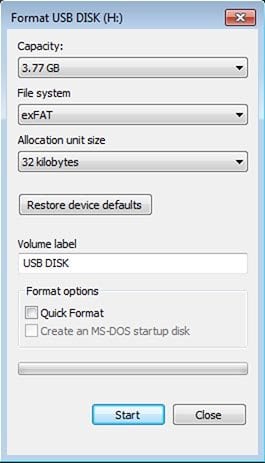
If the format is successful, you will get prompt as shown below. To quit, click CANCEL." Click "OK" and wait for the progress bar to finalize. You will get a pop-up warning you that, " Formatting will erase ALL data on this disk. Step 4: Click Start to begin the process. Check the Quick Format checkbox if it isn't already ticked. Step 3: Click on File System and select exFAT from the dropdown.
#How to format external drive for mac to exfat windows
Step 2: Once it's recognized, open Windows File Explorer and navigate to the disk location. Step 1: Plug in the USB into the computer and wait for it to be detected. For small USB drives of under 32 GB, you can format flash drive to either FAT32 or exFAT. If your USB is small, for example, 4GB, it may not make sense to format it to exFAT because you will never be able to store files larger than 4GB, unless you have the need to transfer files between macOS and Windows devices. For example, you may want to create a different partition for media such as images and videos.Īs mentioned earlier, the exFAT system is ideal for large files and partitions. The nature of your work requires you to have large partitions for different types of data.ExFAT formatted USB drive solves this problem beautifully. In such a situation, your USB drives need to use a file system that is compatible with both operating systems.

You continuously use a flash drive between Windows and Mac.In such a situation, you need to format the USB to exFAT to accommodate large file sizes. As already mentioned, the FAT32 file system has a file limit size of 4GB. exFAT formatted USB drive has no realistic partition size limits.įrom the above descriptions of the three of the main file systems, it becomes immediately apparent why you would need to format a flash drive to exFAT. The system has a file limit size of approximately 16 exabytes (over 1 billion gigabytes!) and is compatible with both Windows and Mac. It was created by Microsoft to replace FAT32 and address its limitations. exFAT: exFAT is an acronym for the Extended File Allocation Table.NTFS is compatible with Windows but files can only be opened in read-only mode in Mac and some Linux distributions. It originally debuted in Windows NT and later in Windows XP. NTFS has a huge file size and partition limits that are theoretically impossible to surpass. NTFS: NTFS or NT file system is the default file system used by Windows.FAT32 also limits partition sizes to 8TB. In today's world where video files can often be larger than that, FAT32 is often impractical.


One of the biggest drawbacks is a maximum file limit size of 4GB. Unfortunately, FAT32 comes with limitations. This is the reason it is also one of the most ubiquitous file systems and comes pre-installed on almost all USB you buy at a store. It currently works on all Windows versions, Mac and Linux. FAT32 was introduced way back in Windows 95 and was the successor to the older FAT16 that was used on Dos and Windows 3. FAT is an acronym for File Allocation Table. FAT32: FAT32 is the oldest file system.


 0 kommentar(er)
0 kommentar(er)
